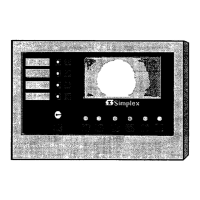Annunciator Overview,
Continued
System Reset and Alarm
Silence Handling
Custom SMPL print statements are not supported by the Graphical LCD
Annunciator. Any custom print statements coming into the Graphical Annunciator
will be ignored. However, since System Reset and Alarm Silence operations
feedback messages on the conventional LCD Annunciator are done through SMPL
print statements in the Master, special handling by the Graphical LCD Annunciator is
required to provide the same textual feedback.
The Graphical LCD Annunciator receives the system print statements, the text itself,
from the master as before. Each statement as a whole is then compared to an internal
table which hold the foreign language equivalent of that message. The 4 100 has 15
system print statements. The statements are listed in Figure 12.
"ALARM SIGNAL TIME LIMIT EXCEEDED"
"ALARM SILENCE INHIBITED, PLEASE WAIT . .."
"ALARM SILENCE IN PROGRESS"
"SILENCE INHIBITED - PANEL IS "ON-LINE""
"SYSTEM RESET INHIBITED, PLEASE WAIT . .."
"ALARM SILENCE/SYSTEM RESET ALLOWED "
"INHIBIT TIMER COMPLETE"
"SYSTEM RESET IN PROGRESS"
"RESET INHIBITED - PANEL IS ON-LINE"
"ALARMS PRESENT, SYSTEM RESET ABORTED"
"NO ALARMS PRESENT, SYSTEM RESET COMPLETE"
"REMINDER - TROUBLE(S) EXIST IN SYSTEM"
"PRIORITY 2 RESET IN PROGRESS"
"PRI2 RESET INHIBITED - PANEL ON-LINE"
"PRI2 ALARMS PRESENT, RESET ABORTED"
"NO PR12 ALARMS PRESENT, RESET COMPLETE"
Figure 12. System Print Statements
Display Time Key
These system print statements are extracted from the 4 100 Programming Unit
DEFAULT PROGRAM 0 and placed in the same file with all the other system
messages.
This key is used to display the time and date of an ALARM, a PRIORITY 2, a
SUPERVISORY, or a TROUBLE event for a point currently on display at the
Graphical LCD Annunciator.
Programmable Control Keys
and Associated LEDs
The four control keys can be configured in a similar manner to the five “Soft” keys in
the Master FACP, using the existing switch programming modes.
The four programmable LEDs can be configured in a similar manner to a generic LED
Point using the existing LED programming modes.
Continued on next page

